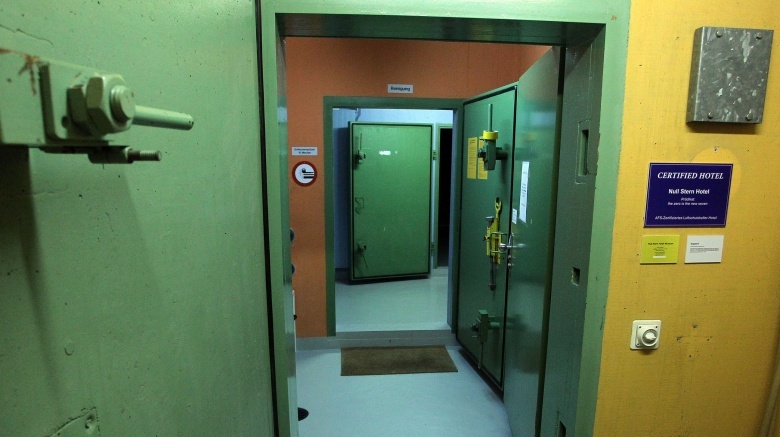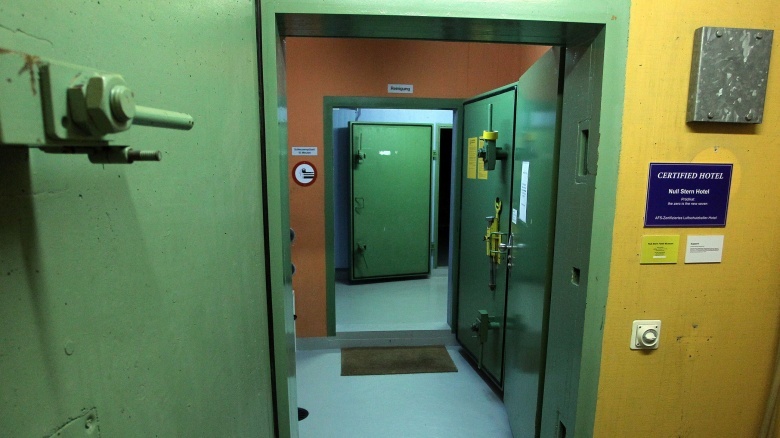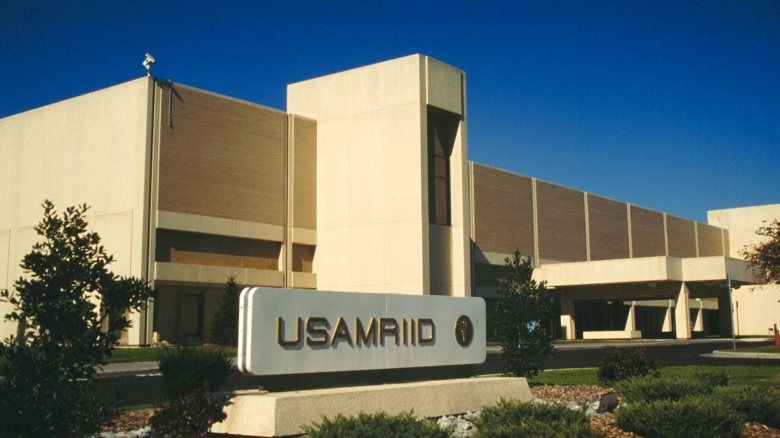The Real Stories Behind These Incredibly Bizarre Buildings
Buildings tell fascinating stories if you just dig into their history. Some buildings are designed by crazy doomsday preppers — some to save our world, and others to possibly destroy it. Here are some of the weirdest and most fascinating.
Church Universal and Triumphant shelter
Mixing Eastern and Western philosophy, Elizabeth Clare Prophet started the Church Universal and Triumphant. Quickly, the religion took on an apocalyptic bend. Prophet gained a strong following through the '70s, and by the mid-80s was prophesying that the world would end on March 15, 1990. To prepare for the coming nuclear apocalypse, her followers started amassing machine guns, armored vehicles and bunkers. Once the nuclear war ended, they would re-emerge as a powerful militaristic organization.
Go to Emigrant, Montana, and you can see the biggest surviving bunker from the Church Universal paranoia. Built out of discarded oil drums, the bunker's huge, fully stocked with food and amenities for up to 90 people. Costing a few million dollars, it was a paranoid labor of love for the members. March 15th came, and 90 people crowded underground. Of course, nothing happened. Disappointed, many of the church members drifted away, refusing to pay $100 a month in upkeep fees.
But Charlie Hull still believes. Hull, a school teacher from Fresno, was one of the biggest believers in the prophecy, spending tons of his own money to build the shelter and lives in it still, faithfully keeping it ready for the end of the world, while giving tours for the curious. When interviewed, Hull actually didn't seem super convinced of the doctrine anymore, stating "I do wonder whether it was a good idea sometimes. You get to thinking about the trips to Hawaii you could have taken instead."
Switzerland's shelter system
When most people think of Switzerland, they think of chocolate, watches, or bank accounts. But nobody thinks of Switzerland as a place filled with nuclear warfare paranoia. According to their national laws though, the secret defining feature of Switzerland is probably just that, with the Swiss government taking measures to fill their country with hardened fallout shelters.
Swiss federal law states that every citizen must have access to a fallout shelter, and the Swiss take that law very seriously. As of now, there are 300,000 shelters in Switzerland, providing 114% coverage for its population. That means they have more shelter capacity than people in the country! Fallout shelters are everywhere, and many buildings double as bunkers, like the Sonnenberg tunnel, a highway bypass tunnel that can double as a shelter in times of nuclear war.
If you visit Switzerland, make sure to look around to spot fallout shelters. Many buildings have them. Even private residences can have a fallout shelter in their basement. And don't think this is just a holdover from the Cold War. According to the government, 50,000 shelters come on-line each year, with money for the network coming out of taxes. If nuclear warfare comes to planet Earth, Switzerland is shockingly the safest place to be.
Abo Elementary School
It looks like a standard school in a suburban neighborhood, but the Abo Elementary School in Artesia, New Mexico, is the only elementary school designed to withstand a nuclear strike. From the street, the school is just a series of entrances, as the school is mostly underground. Oddly, the interior of the school looks like what you would expect from an elementary school.
Pull away the bright colors from the classroom walls, and Abo Elementary school reveals its true purpose. Designed in 1962 during the height of the Cold War, the school was the first of many planned nukeproof schools. The doors to the school are 1,800 pound blast doors, and the entrances contained decontamination showers for nuclear emergencies. It could withstand a 20-megaton blast from 10 miles away, while backup generators and a water well could sustain up to 2,160 people. One of the classrooms that students attended class in doubled as a morgue. And you thought detention was depressing.
The school shut down in 1995, but it still stands today, a relic from a bygone era. But should a nuclear strike come, Artesia residents can rely on some protection from the blast doors leading to this odd underground school. This would be an excellent setting for a Walking Dead spin-off.
Ark Two
The largest survival shelter in Canada eschews the normal bunker style. Instead of just a big tube, architect Bruce Beech designed Ark Two by burying 42 school buses underground. Each of the school buses became a different type of structure in the compound. Some are hallways, others bathrooms, and others living quarters. Beech believes that his shelter is the best place for any prepper itching to wait out the apocalypse.
Ark Two is still a work in progress, with Beech constantly adding new additions to the compound. According to his website, the shelter will soon get a fully stocked surgery room and a library. With room for up to 500 people, Beech plans to create his own society underground, that can rise up from the ashes of the old world. But the Canadian government is not thrilled about Ark Two. Beech's local fire department has constantly tried to shut down the bunker, claiming it to be a fire hazard. After the first attempt, Ark Two became a symbol for conspiracy theorists who believe that New World Order globalists are trying to kill off 90% of the world's population, while fearing enlightened survivalists like Beech. But if the New World Order is really trying to get Beech, we'd think that they would use something more sinister than the local fire department. Like belt shots and spray paint.
3970 Spencer St.
Nestled just off the Las Vegas strip is the entrance to an underground house. The surface is a nondescript doorway next to a suburban two-story house. But 3970 Spencer St. is much, much more. Built during the Cold War, this is an underground house designed to keep inhabitants entertained when the Soviets wipe out Las Vegas.
3970 Spencer St. is a huge underground compound, and in the middle sits a functional two-bedroom house. Surrounding the house is a full backyard complete with a putting green, jacuzzi, sauna, BBQ pit, whirlpools, and dance floor. The walls feature hand-painted murals showing the surrounding neighborhood, as it appears top side. Adjustable lights provide artificial daylight, and the bunker simulates the normal day/night cycle. A tunnel (now filled in) connected the bunker with the original owner's place of work, giving him a quick escape should nukes start falling.
After the Cold War, the absurd bunker fell into disuse, becoming a tourist attraction filled with '70s pop culture memorabilia. However, the bunker was recently purchased by a mysterious group called the Society for the Preservation of Near Extinct Species. Good luck finding any information about the society — they have almost no internet presence. For some reason, they've decided that they need this odd underground bunker and, unless Putin goes crazy with the bombs, we will probably never know why.
USAMRIID
From the outside, USAMRIID looks like a normal office building. Inside, however, is enough biohazards to wipe out a good chunk of the United States.
USAMRIID stands for United States Army Medical Research Institute of Infectious Diseases, and is the only Department of Defense-operated facility cleared for Biosafety Level 4 research. Anybody working with the diseases inside USAMRIID must wear positive pressure suits, and pass intense security checks to get inside. USAMRIID keeps samples of the worst biohazards, ranging from anthrax to botulism and ricin toxin — those are just the ones known to the public, by the way. All these are incredibly deadly, and should USAMRIID ever get breached, it could be the epicenter for a bio-disaster of epic proportions.
But at least you have nothing to worry about, since it is really secure right?
Ha, no. Wrong. USAMRIID has had its fair share of mishaps. The anthrax breakout during the 2000s was ultimately traced back there, with investigators finding that lax safety procedures allowed a homicidal doctor named Bruce Ivins to get the toxin outside. Then, in 2010, a worker was accidentally trapped in a -30 degree Fahrenheit freezer, almost resulting in her death. These issues lead us to believe that if the zombie apocalypse ever comes, it will probably start at USAMRIID.
AI V. Corbi Fortified Manse
Strategically Armored & Fortified Environments (SAFE) is a security company for the super rich and ultra-paranoid. Specializing in designing houses impervious to attack, SAFE is well-regarded in the home security field. Unsurprisingly, founder Al V. Corbi is absurdly paranoid, and saved the best technology for his own fortified Los Angeles fortress.
Corbi's house sits atop a hill overlooking the city. From the exterior, the house is stunning. Inside, it's a technological marvel. Starting from the bottom, Corbi had the house build on thick support beams burrowed deep into the house. The whole hill could get blown away and the house would still stand on the beams, like an oil rig. All of the doors have state-of-the-art sentry equipment which screens visitors to decide who can enter the house and who gets locked out.
The interior of the house, meanwhile, includes two "safe cores," bedrooms that can seal themselves off from the rest of the house in case of emergency. Each floor of the house has surveillance measures accessible by Corbi from anywhere in the world. In case of evacuation, Corbi has contracted a local helicopter company to come pick him up 24/7, using the helipad on top of the house. The manse is so well-fortified, it makes us wonder what Corbi thinks will happen to Los Angeles in the near future.
Granite Mountain Records Vault
One of the weirder Mormon beliefs is baptisms for the dead. According to their scriptures, Mormons can baptize people into their church after they're dead, making them posthumously Mormon, whether they want to or not. Getting the names for the baptisms is a huge task, and requires tons of storage space, which led them to dig out a huge genealogical storage facility in the mountains of Utah.
Getting into the vault is extremely difficult, requiring passing through intense security screening, but Granite Mountains Records Vault's main purpose is to protect the Mormon genealogical records. Stored on microfilm, the vault has 1.7 million rolls of film, a huge chunk of the world's genealogical records. Outside of Mormon theological practices, it's easy to see how important this vault is. Since it is nearly indestructible from the outside (it sits under 300 feet of solid granite), even if a terrible disaster hits, the human race would still have records of our ancestors.
But the vault also has some interesting conspiracy attached to it. Rumors state that, inside the vault, Mormons keep large amounts of historical documents, some of which could be extremely damning to the church. Known items that are kept in the vault include magical "seer stones" that founder Joseph Smith used to allegedly translate the Book of Mormon, secret letters from Joseph Smith, code books from early church leaders, and detailed diaries from the original Utah pioneers. Who knows what else they're keeping there, but the facility sounds eerily similar to the storage facility at the end of Raiders of the Lost Ark, so probably at least one Ark.
Ed Peden's House
The midwest of the United States is dotted with relics from the Cold War. During hostilities, the flat farmland made excellent sites for nuclear silos. After tensions cooled, many of the silos got decommissioned, but you can't just dig a silo out of the ground, so the US government left the silos where they were. This created an odd market, one where doomsday preppers snatched up the old silos at bargain prices, and began to renovate them as homes.
Out of all the silo houses, none are as spectacular as Ed Peden's. Residing 25 miles away from Topeka, Peden's silo could launch Atlas missiles. For the price of only $40,000, Peden bought it and got to work. The launch control room became a living room, and the storage areas for the missiles were converted into garages and bedrooms. To keep the silo livable, Peden installed a robust air filtration system with strong dehumidifiers.
Besides the creature comforts, the silo has another important advantage: it can survive a one-megaton airburst nuclear bomb, a feature we feel more houses should have. According to Peden, this makes the silo ideal to raise a family, although he does believe that the house has residual "serious energy" from the tensions of the Cold War, and he's concerned about getting old in the house: "I don't know what it's gonna be like to get old out here. I've got to climb twenty feet up to change the light bulbs in the missile bay."
That, unfortunately, is the price one pays to survive the ending of Dr. Strangelove.


